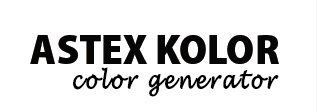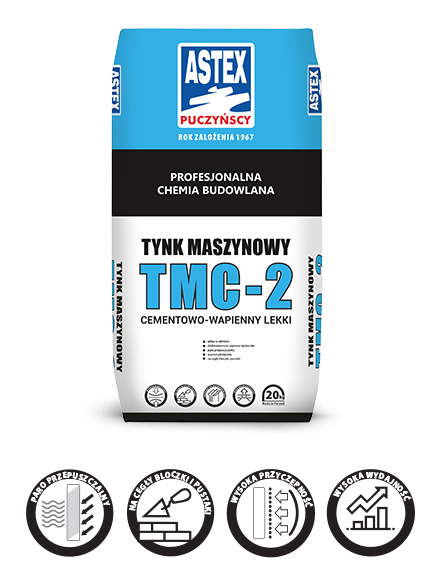TMC-2 machine plaster
Light cement-lime plaster TMC-2 is designed for machine or manual execution of internal and external plasters.
- Available in white and gray
- Highly efficient
- Easy to process
- Fine-grained
- Vapor permeable
- Highly malleable

Calculate expenditure
Expenditure
15 kg / m² for 1 cm thickness of mortar
Thickness of a layer
From 5 to 15 mm
Shell life
12 months from the date of production
Packaging
20 kg
Application
Lightweight cement-lime plaster is intended for machine or manual execution of internal and external plasters. It is used in small and large-scale construction, both for newly constructed buildings and those being renovated (living quarters, basements, garages, halls, etc.). Lightweight cement-lime plaster is intended, among others for mineral substrates: concrete, ceramic, for concrete blocks, hollow bricks, bricks, for sand-lime substrates, chip-cement boards, etc. It is also used as a primer for precious plasters. Suitable for single or multi-layer application.
Properties
Lightweight cement-lime plaster is a ready, dry mix of the highest quality, based on gray or white cement, specially selected aggregates, perlite and modifying additives. It is characterized by good plasticity and adhesion to various types of building materials, which makes it a product with a very versatile application and easy to process. With very high adhesion to the ground. Special chemical modification eliminates the effect of sliding of a freshly applied layer. Cement-lime mortar is a frost and waterproof product. Full strength is obtained after 28 days from the end of application.
Substrate preparation
The substrate should be dry, matured, stable, even and sound, i.e. strong enough, cleaned of layers that may weaken the adhesion of the plastering mass (dust, dirt, lime, oils, fats, wax, residual oil and emulsion paint). Excessive absorbency of the substrate should be reduced by using UNI-ASTEX priming emulsion. If it is necessary to make a layer of plaster on solid substrates with a load capacity difficult to determine (e.g. dusty, difficult to clean), it is recommended to carry out an adhesion test consisting in applying a control layer and checking the connection after a minimum of 48 hours. To avoid the formation of cracks in typical places (structural joints, two or many different substrates in the plane and in corners to protect against increased stresses above and below the edges of window and door openings), it is necessary to use concealed mesh or other materials (expansion joints) provided for this type of joints . The so-called cement spokes (the thickness should be not less than 2 mm). Substrate preparation can be carried out using e.g. leveling profiles, corner profiles, which should be glued or attached to the substrate in advance so that the profiles are stable and do not move when applying the proper plaster layer.
Mortar preparation
Pour the contents of the package into the plastering unit. When applying manually, mixing consists of pouring into the container the right amount of plaster mortar and a measured amount of water. Then mix the mass manually or mechanically using a drill with a mixer until a homogeneous mass without lumps is obtained. When mixing without an aggregate, if necessary - add a small amount of water and mix again. Do not add other ingredients such as sand, cement, etc. The mortar retains its working properties for about 1-1.5 hours from the moment of grinding, therefore it is recommended to prepare only such portions that will be used at that time. The mortar should be mixed again immediately before use. The mortar should be applied evenly on the plastered surface.
Application method
Plaster mortar is applied after the substrate has been prepared in advance (on previously matured cement and lime SZPRYC plaster min. 3-5 days from the end of application). The mortar should be applied with a machine aggregate for machine plasters or manually with a trowel.We start work from horizontal surfaces (ceilings), then vertical surfaces. The mass should be applied evenly with horizontal stripes starting from the bottom and heading up the surface. It is unacceptable to apply too thick layer exceeding the standard values in construction once. If it is necessary to apply a thicker layer, the works should be divided into 2-3 stages with appropriate time intervals (while maintaining the weather and ambient conditions specified on the packaging, this time is 3-4 hours). A single application of a layer of plaster over 2 cm will cause the plaster to crack on the surface. After applying the mortar, proceed to the initial leveling of the surface by collecting excess plaster using building battens. The resulting defects should be filled up with excess mass collected during leveling, or apply fresh material and smooth again until a uniform surface is obtained. Depending on the expected finish effect and further use of the surface (plaster category), it should be smoothed (e.g. for subsequent layers of paint or finishing coats) using a polystyrene or felt trowel. If the applied plaster is to be the base for ceramics or finishing elements, the plaster should be left rough (not smoothed). The processing time as well as the drying time depends on the parameters of the substrate and the environment. Application of subsequent layers of cement-lime plaster should take place after the initial binding of the previous layer of plaster. During the drying of plasters inside the room, good ventilation must be provided. For outdoor plasters, the applied layer should be protected against direct sunlight (drying out too quickly, which may lead to cracking of the plaster), and the surface should be protected against direct rain. The air and surface temperature must be positive. Before starting further work, make sure that the plaster surface is sufficiently dry. In addition to the recommendations provided, work should be carried out in accordance with building practice and health and safety rules. The manufacturer guarantees the quality of the product, but has no effect on the conditions and the way it is used. If in doubt, carry out adhesion tests.
Cautions
Work in temperature between +5 ° C and +25 ° C. For a period of 7 days after the completion of works, the air temperature should not be below + 5 ° C, and for the next 21 should not fall below 0 ° C. Protect freshly applied plaster from drying too quickly, spray with water if necessary. Do not use electric and gas heaters (risk of shrinkage scratches). All dirt on building components and tools should be cleaned with water or mechanically after drying, setting the mortar. When priming walls on light cement-lime plaster, "cobwebs" may occur, i.e. various types of irregular discoloration, in the shape of irregular shapes, vertical lines, horizontal bevels, etc. This type of phenomenon is not a material defect. After drying, the discoloration disappears and has no effect on painting, application of coats, etc., provided that these discolorations and lines do not have cracks.
Drying time
At a temperature of + 20 ° C and a relative humidity of 65%, the plaster can be further processed, taking one day for every 0.5 cm thick with 100% surface coverage. In case of high humidity or low temperature, drying time may change.
Expenditure
On average, 1 kg / m² is used for 1 mm thick mortar. Layer thickness from 5-15 mm. In practice, the wear depends on the degree of evenness of the substrate. The proportion of the mixture with water is about 5-5.5 liters of water per 20 kg of dry mix.
Tools
Aggregate for applying machine plasters with a gun, drill with a mixer, agitator, cement mixer, trowel, foam spreader, felt float, leveling patches, trowels. Tools should be cleaned with clean water directly after use.
Storage and transport
The products must be absolutely stored in undamaged packaging and dry rooms on pallets. Protect against moisture, moisture during storage and transport. The storage period of the product in conditions complying with the recommendations given is up to 12 months from the date of production placed on the packaging in digital print. The production date, which is placed on the packaging, is also the date of manufacture of the product. Any changes in the structure of the product or packaging that are visible without specialized tests, in particular discoloration or smudging of the packaging graphics, infringements of the continuity of the packaging, biological changes in the structure of the product, recognizable in particular as a consequence of moisture, may indicate poor storage or transport conditions and do not guarantee compliance declared product performance according to specifications.
Packaging
20 kg paper bags. Pallet: 60 bags, 20 kg each = 1200 kg.
Precautions
The product contains cement which, when mixed with water, gives an alkaline reaction. Take measures to prevent dusting or splashing with the mortar. Do not inhale, protect eyes and skin. In case of contamination: rinse eyes immediately with plenty of clean water and seek medical advice, wash skin with soap and water. Keep out of reach of children. If swallowed, seek medical advice immediately and show the container or label.
Temperature of performed work
Air temperature from + 5 ° C to + 25 ° C. Substrate temperature from + 5 ° C to + 25 ° C. Work in temperatures between + 5 ° C and + 25 ° C. For a period of 7 days after the completion of works, the air temperature should not be below + 5 ° C, and for the next 21 days should not fall below 0 ° C.
Do you have questions? Doubts? Ask an advisor Contact form












